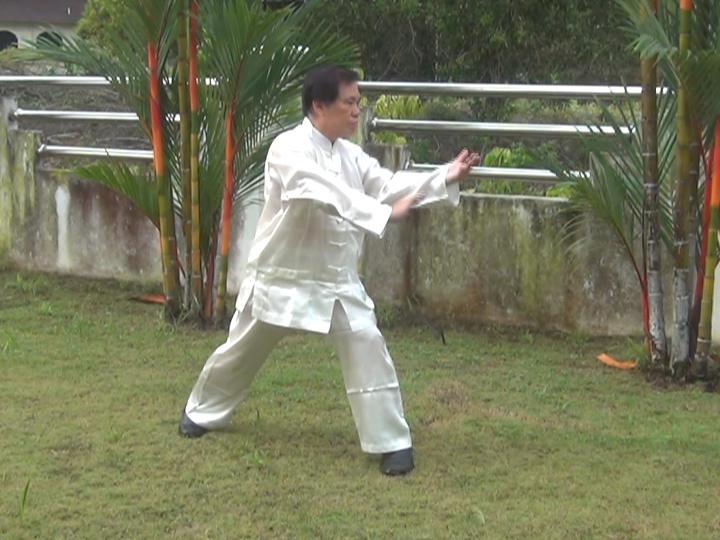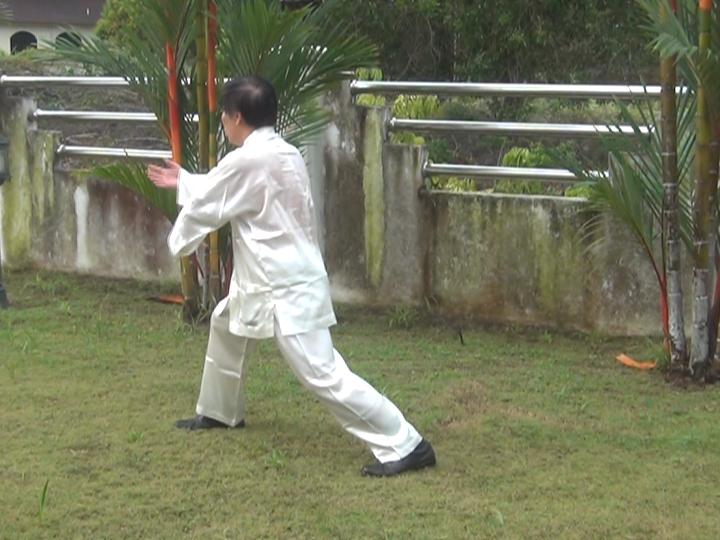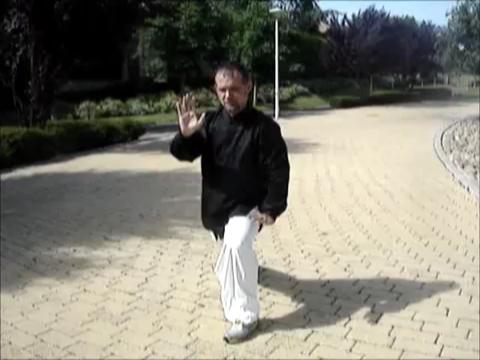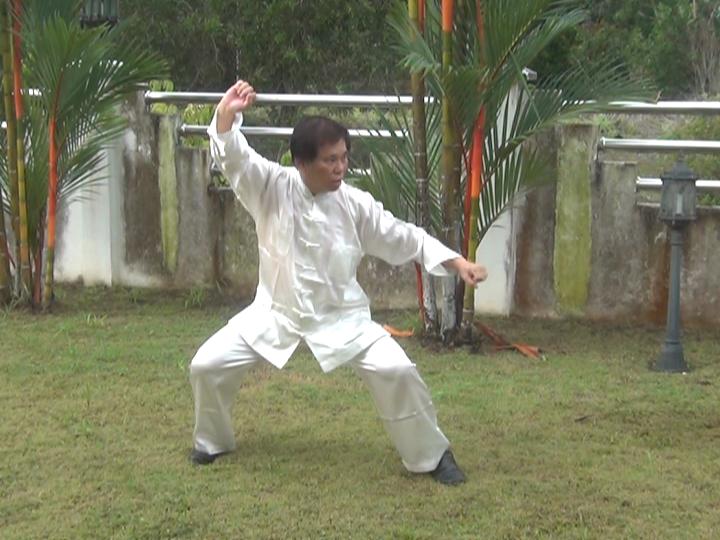LEFT AND RIGHT MODES, AND MIRRORING A SET

In the orthodox version of the 108-Pattern Yang Style Taijiquan Set, Grasping Sparrow's Tail is performed on the left side
Question
Is there a difference if the repetitions and mode changes are practiced within a set vs repeating the 24-Pattern set a few times?
Is it advisable to mirror complete sets?
Is it advisable to mirror the basic of Tai Chi Chuan combat sequences to practice the applications on both sides?
“Wild Horse Separates Mane” is a frequent pattern in Yang Style Tai Chi Chuan and happens to be one of my favourites. I have noticed that it is found in at least three selective sets, but not included in the standard syllabus. Is it because its applications are too sophisticated?
Sifu Leonard Lackinger
Answer
Yes, there is a difference between practicing the 108-Pattern Set and repeating the 24-Pattern Set, regardless of whether we consider the original version or our Wahnam version.
Many patterns in the original version of the 108-Pattern Set, including the core patterns of Grasping Sparrow’s Tail, are performed only on one mode, whereas these patterns are performed on both modes, left and right, in the 24-Pattern Set. A practitioner of the original version of the 108-Pattern Set, therefore, would not be as efficient in using the other mode of these patterns in combat.
There is more variety of patterns in the 108-Pattern Set, and these extra new patterns are not found in the 24-Pattern Set, like Strike Tiger, Seven-Star and Sway-Lotus Kick. However, the patterns in the 24-Pattern Set are sufficient to meet all attack situations in general. The extra patterns are useful only in special situations.
Hence, between these two sets of the original version, I prefer the 24-Pattern Set. It is superior to the 108-Pattern Set in both combat and health purposes.
It was precisely to overcome these setbacks of the original 108-Pattern Set that I modified it, resulting in our Wahnam version of the 108-Pattern Set. I also slightly modified the original version of the 24-Pattern Set by adding the Shoulder Strike and the Elbow Strike, which were also added to the 108-Pattern Set as these techniques are not found in the original version.
When we compare our Wahnam versions of the 108-Pattern Set and the 24-Pattern Set, the setback of only one mode of core patterns no longer applies, but the longer set has the advantage of greater variety of patterns. Another advantage of the longer set is that the arrangement of its sequences is more effective for combat. Hence, in my opinion, it is superior to the 24-Pattern Set.
If we take both sets and both versions, my preference in descending order, i.e. the best choice first, is as follows:
108-Pattern Set Wahnam Version -> 24-Pattern Set Wahnam Version -> 24-Pattern Set Original Version -> 108-Pattern Set Original Version
It is not advisable to mirror complete sets, and this comment also applies to the original version of the 108-Pattern Set. If it was necessary to have both the left and the right modes in a particular set, the master composing it, if he was worth his name as a master, would have both modes but not necessary as a mirror.
The patterns are performed in both the left and the right mode in the Wahnam version of the 108-Pattern Set, and in both versions of the 24-Pattern Set, with a few exception like Needle at Sea Bottom, Elbow Strike and Sway-Lotus Kick. Does having both modes in our Wahnam version of the 108-Pattern Set contradict the statement that it is not necessary to mirror a set, like the original version of the 108-Pattern Set, if it has only one mode? No. It is not necessary to mirror the original version, but having both modes in our Wahnam version is better.

In the Wahnam version of the 108-Pattern Yang Style Taijiquan Set, Grasping Sparrow's Tail is also performed on the right side
The time spent for mirroring the set can be used for other purposes. If a left mode is preferred but not available, like applying a left ward-off against a left palm strike, a practitioner of the original version of the 108-Pattern Set can use another pattern, like Jade Girl Threads Shuttle.
There are subtle differences between using the left mode of warding off, and using Jade Girl Threads Shuttle, but for combat in general, Jade Girl Threads Shuttle is an adequate substitute.
Mirroring a set would take double the amount of time for practice. It is not justifiable to spend the large amount of extra time for this little benefit.
Even if we suspend the consideration of time, it is still not advisable to mirror a set, especially a long, asymmetrical set like the original version of the 108-Pattern Set. It would make the practice boring.
It is worthwhile to note that mirroring a complete set is quite different from having both the left and the right modes included in a set. The former is boring, whereas the latter is not.
Even practicing a set like Lohan Asks the Way, where both the left and the right modes are arranged symmetrically, unlike our version of the 108-Pattern Set where the left and the right modes are not arranged symmetrically, is different from mirroring a complete set, even a short one like Black Tiger Steals Heart of Shaolin Kungfu or White Snake Shoots Venom of Taijiquan.
All these setbacks in the original version of the 108-Pattern Set are not only overcome but are turned into advantages in our Wahnam version. The time taken to perform the original version and our Wahnam version is about the same, but not only we have both the left and the right modes in our version, but also we can go deeper into finer points.
For example, a practitioner of the original version would use a right ward off against a thrust punch, irrespective of whether an opponent uses a right thrust punch or a left thrust punch, because the practitioner only learns the right mode. This is permissible at an elementary stage.
But there are differences between using a right ward off or a left ward off against a left thrust punch. When an exponent uses a right ward off against a left thrust punch, not only he is exposed but also he misses the opportunity to close an opponent adequately, a principle we effectively use against Boxers. Those who practice the original version would miss these finer points.
If he is lucky enough to learn from a competent teacher, instead of using a right ward off against a left thrust punch, a practitioner of the original version may use Jade Girl Threads Shuttle, using his left hand to float an opponent’s left punch, and his right palm to strike the opponent. But he would not use a left ward off, simply because he has not learnt it.
Again in this case there are differences between using Jade Girl Threads Shuttle and using a left ward off. If an opponent is short and powerful, or tall and skillful with kicks, using a left ward off would be superior to using Jade Girl Threads Shuttle. Practitioners of the original version would not have the opportunity to learn these finer points.
It is not necessary and not advisable to mirror the basic Taijiquan combat sequences to practice the applications on both sides. The combat sequences are composed in a way that the best techniques are employed in the given situations by both the initiator and the responder according to the aims and objectives of the training as well as their level of attainment. Hence, mirroring the combat sequences is not only boring and wasting time but also will miss applying the best techniques for the occasions.
Let us take the first Taijiquan combat sequence, Immortal Waves Sleeves, for illustration. Please bear in mind that we do not train just one combat sequence in isolation. Every combat sequence is a part of the whole system providing comprehensive combat training.

Sifu Manual Tirado performing the 24-Pattern Simplified Taijiquan Set
There are good reasons why the initiator moves in with his right leg and attacks with his right palm. The right hand is the emperor-hand, which can be effectively used for both attack and defence. Developing the emperor hand in this way is an important aim of the sequence. Using the right leg in front facilitates waist rotation, a very important principle students put into practice right at the start of their combat training.
If a practitioner uses his left hand instead of his right, he would not be training his emperor-hand. What about a left-hander? Should be reverse the mode of the sequence? He can, but it will not be to his advantage. A big disadvantage is that using his left hand, even when it is his better hand, does not enable him to use the best techniques in the given situation. Moreover, if he trains according to the arrangement in the sequence, gradually his right hand will be as adroit as his left hand, which gives him an added advantage over most people who are right-handers.
If a practitioner uses left leg in front instead of his right leg, the aims and objectives of this sequence will be compromised. He would not, for example, have an ideal position to train waist rotation. Consequently his training to use an opponent’s momentum against himself will be affected.
If he trains only with his right hand and his right leg in front, will he be competent to use his left hand and his left leg in front? Yes, this will be practiced in other sequences for both attack and defence. All the modes -- right-right, right-left, left-left, left-right -- are found in the 12 basic Taijiquan combat sequences.
Students practice all these modes not by mirroring the combat sequences. These modes are used when they are advantageous in certain given combat situations. In other words, if a student uses left-left, it is not because he wants to mirror right-right, but because in that given combat situation, left-left is a choice mode. For example, in Combat Sequence 10, Cloud Hands, the left-left mode is used in Low Stance Vertical Punch in response to an opponent’s Jade Girl Threads Shuttle in this situation. Changing to a right-right mode would be inappropriate.
But you are not thinking of just reversing the mode of this one pattern, you are thinking of mirroring the whole sequence, changing every left to right and vice versa. This issue is irrelevant because had you started with a different mode from the one prescribed in the sequence, many or all the patterns in the sequence will be different as every pattern is chosen as the best response for that particular situation in question.
If we do not mirror our combat sequences, would we be able to respond correctly and spontaneously if an opponent, despite many disadvantages, uses another mode other than the one in the sequence? Of course, we can. We are trained to respond correctly and spontaneously to the situation, not according to the routine of a sequence.
Suppose in Sequence 1, an opponent attacks you with his left vertical punch in a left side-way Horse-Riding Stance, i.e. using the left-left mode instead of the right-right. You can follow the sequence and brush off his attack with your right Low Cloud Hands, in which case you are in a better advantage than had your opponent used the original right-right mode. Or you may respond as in Sequence 10, using a right Low Stance Vertical Punch to strike him using the tactic of no-defence-direct-counter. Or you may grip his arm using Old Eagle Catches Snake, a slight modification of mode in Sequence 10.
Besides being found in the 108-Pattern Set, Cloud Hands Grasp Sparrow, and Wudang Taijiquan, “Wild Horse Separates Mane” is also found in Shaolin Five-Animal and Dragon Strength, but is called “Majestic Dragon Across Stream”.
This pattern is not found in our standard Taijiquan syllabus because when I composed the sets for the standard syllabus, I did not find this pattern the best choice for various situations in the combat sequences.
Historically, the Taijiquan syllabus was a mirror of the Shaolin syllabus. The Shaolin syllabus was devised to meet expedient needs. The two main needs were force training and combat application, which were also the two pillars of any genuine kungfu training in the past.
In the Shaolin syllabus, force training was taken care by stance training and One-finger Shooting Zen. In Taijiquan, force training was taken care by stance training and Lifting Water, later replaced by Cloud Hands and reinforced by Grasping Sparrow’s Tail.
For combat application I composed 16 combat sequences for Shaolin Kungfu. These 16 combat sequences were formulated into 4 fundamental sets. These 16 combat sequences were crystallized into 12 combat sequences in Taijiquan, and the 12 sequences were also formulated into 4 fundamental sets.
In composing the combat sequences, I covered all the four categories of attack, namely striking, kicking, felling and gripping. I also selected the best patterns for the attack and defence situations. “Wild Horse Separate Mane” was not one of these selected patterns.
Before students could apply patterns for combat, they needed to be familiar with basic patterns. In Shaolin Kungfu, I chose the four basic strikes and their defences to formulate Lohan Askes the Way, the first basic Shaolin set.
The first basic Taijiquan set, White Crane Flaps Wings, was more sophisticated. It was built upon a more elementary set, Cloud Hands, which I first taught in Spain and later in a VIP course in Colombia. I added kicking, felling and gripping techniques to Cloud Hands to make the set comprehensive.
“Wild Horse Separates Mane” was not in the original set, Cloud Hands, which consisted mainly of Grasping Sparrow’s Tail, Single Whip and Green Dragon Shoots Pearl. “Wild Horse Separates Mane” was also not used in the kicking, felling and gripping techniques. But its modified form, Immortal Waves Sleeves, is a fundamental pattern in the standard Taijiquan syllabus.
Hence, a direct answer is No, Wild Horse Separates Mane is not included in the standard syllabus not because its combat applications are too sophisticated, but because it was not a choice pattern for attacks and defences in the combat sequences which eventually formed the syllabus.
Nevertheless, an indirect answer is Yes, it was not a choice pattern because its combat applications are too sophisticated to be included in the basic attacks and defences which formed the syllabus.

Striking Tiger Poise is a pattern added to the Wahnam version of the 108-Pattern Yang Style Taijiquan Set
The question and answer are taken from the thread Yang 108-Pattern Set: 10 Questions for the Grandmaster in the Shaolin Wahnam Institute Discussion Forum.
